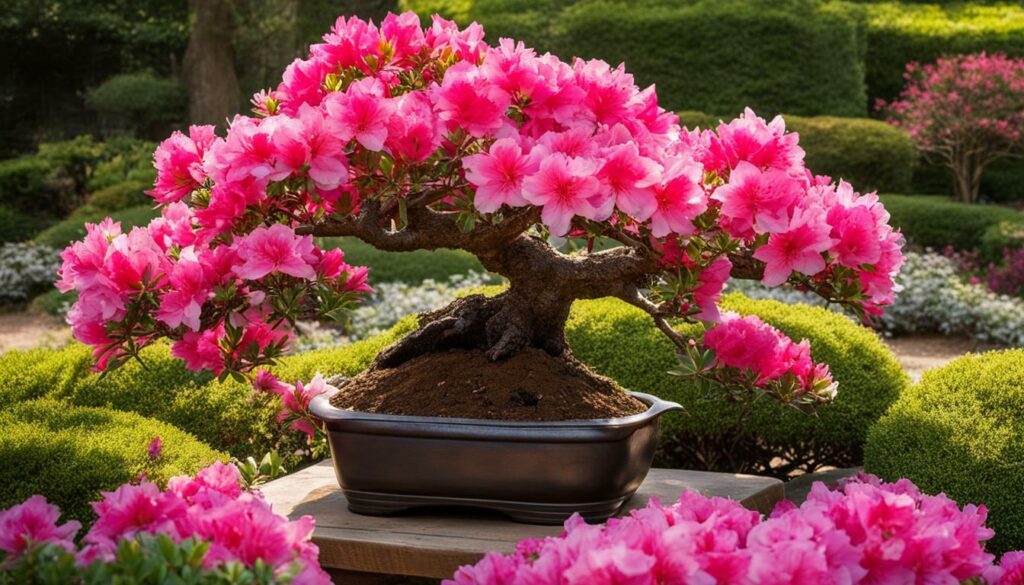Welcome to the complete caring and maintenance guide for ‘Azalea’ Bonsai, an exquisite gem in the bonsai world. Azalea bonsai care is crucial for the health and longevity of this popular bonsai tree. Whether you are a beginner or an experienced enthusiast, this guide will provide you with all the essential information you need to properly care for your Azalea bonsai.
- Placement is crucial for Azalea bonsai, as they thrive in sunny locations but should be protected from extreme heat and rain.
- Proper watering is essential to keep the soil moist but not overly wet, and using rainwater or filtered tap water is recommended.
- Fertilizing with azalea or rhododendron-specific fertilizers during the growing season is necessary, but feeding should be reduced while the tree is flowering.
- Pruning and wiring should be done carefully, with emphasis on pruning the lower branches more aggressively than the top to maintain the shrub-like shape.
- Repotting every two years, in spring or after flowering, is necessary for Azalea bonsai, and special azalea soil should be used.
Table of Contents
ToggleUnderstanding ‘Azalea’ Bonsai Care
To ensure the health and beauty of your ‘Azalea’ Bonsai, it is crucial to understand the specific care requirements. Azalea bonsai care involves a combination of proper placement, watering, fertilizing, pruning, and protection against pests and diseases. Let’s explore each aspect in detail:
Placement and Lighting
Azaleas thrive in sunny locations with partial shade, but they should be protected from extreme heat and rain. Place your bonsai where it can receive filtered sunlight for at least 4-6 hours a day. Avoid placing it near radiators or heating vents, as these can cause rapid drying of the soil and foliage. Providing the right amount of light will promote healthy growth and vibrant blooms.
Watering and Soil Moisture
The proper watering technique is essential for azalea bonsai care. Keep the soil moist but not overly wet, as soggy soil can lead to root rot. Check the moisture level by inserting a wooden skewer or your finger into the soil about an inch deep. If it feels dry, it’s time to water. Use rainwater or filtered tap water to prevent damage from chemicals present in tap water. Avoid using hard water, as it can affect the pH level of the soil.
Fertilizing and Feeding
Azalea bonsai require regular feeding during the growing season to ensure their vitality. Use azalea or rhododendron-specific fertilizers to provide the necessary nutrients. Fertilize every two weeks from spring to early fall, but reduce feeding while the tree is flowering to avoid interfering with blooming. Always follow the instructions on the fertilizer packaging for the correct dosage and application method.
Pruning and Wiring
Pruning and wiring are essential techniques for shaping and maintaining the desired form of your azalea bonsai. Prune the lower branches more aggressively than the top to maintain the shrub-like appearance. Remove any dead, damaged, or inward-growing branches. Wiring should be done with caution, as azalea branches can be brittle. Use aluminum or copper wire, and make sure not to wire too tightly to avoid damaging the branches. Prune and wire your bonsai during the late winter or early spring, before new growth emerges.
| Aspect | Guidelines |
|---|---|
| Placement and Lighting | Filtered sunlight for 4-6 hours a day, protect from extreme heat and rain |
| Watering and Soil Moisture | Keep soil moist but not overly wet, use rainwater or filtered tap water |
| Fertilizing and Feeding | Use azalea or rhododendron-specific fertilizers, fertilize every two weeks |
| Pruning and Wiring | Prune lower branches more aggressively, wire with caution |
Understanding the specific care requirements for your ‘Azalea’ Bonsai will help you create an environment where it can thrive. With proper placement, watering, fertilizing, pruning, and protection against pests and diseases, you can enjoy the beauty of this popular bonsai tree for years to come.
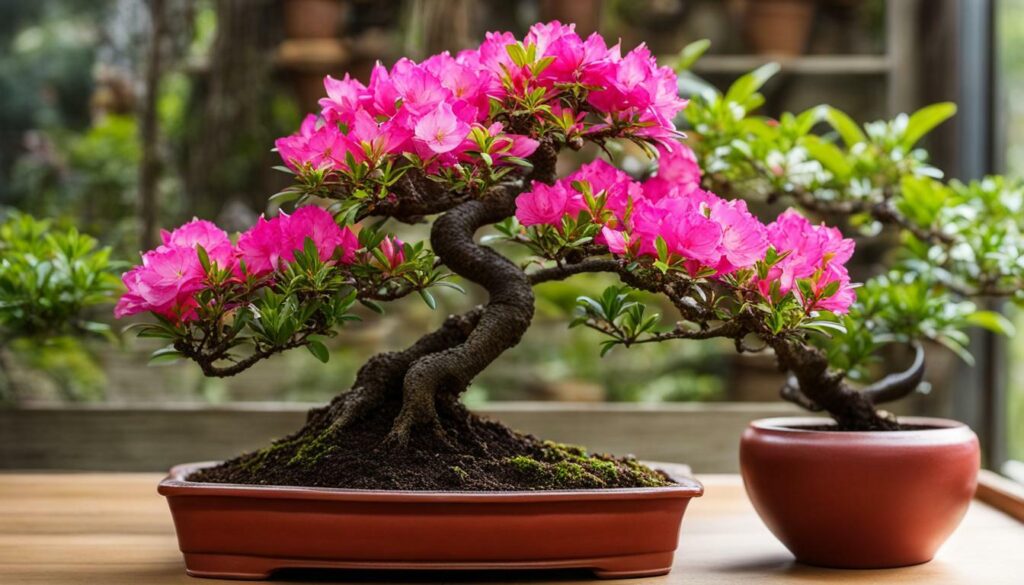
Proper care ensures the health and beauty of this popular bonsai tree.
Placement and Lighting
Finding the right spot for your ‘Azalea’ Bonsai is essential for its overall health and growth. Azaleas thrive in sunny locations, so it is important to provide them with ample sunlight. However, they should also be protected from extreme heat and heavy rain, as these conditions can be detrimental to their well-being. A sunny balcony or patio can be an excellent outdoor spot for your Azalea Bonsai, as long as it is shielded from scorching afternoon sun and excessive downpours.
If you choose to keep your Azalea Bonsai indoors, place it near a bright window where it can receive indirect sunlight. Optimal indoor temperature for Azaleas is around 60-70°F (15-21°C). Avoid placing your bonsai near heating or cooling vents, as rapid temperature changes can harm the plant.
Proper placement and lighting ensure that your Azalea Bonsai receives the necessary sunlight without being exposed to harsh weather conditions or extreme temperatures. This will contribute to its overall health and enhance its potential for vibrant growth and beautiful blooms.
| Sunlight Requirements | Outdoor Placement | Indoor Placement |
|---|---|---|
| Full Sunlight | 4-6 hours of direct sunlight daily | Place near a well-lit window with indirect sunlight |
| Partial Sunlight | 2-4 hours of direct sunlight daily | Place near a window with filtered sunlight |
“The right placement and lighting conditions are crucial for the growth and vitality of your Azalea Bonsai. By providing the ideal amount of sunlight and protecting it from extreme weather, you can create an optimal environment for your bonsai to thrive.”
Watering and Soil Moisture
Adequate watering is vital to maintain the optimal moisture level for your ‘Azalea’ Bonsai. These delicate trees require consistent watering, ensuring the soil stays moist but not overly wet. To achieve this, it is recommended to water your Azalea Bonsai thoroughly, allowing the water to reach the roots, but ensuring there is proper drainage to prevent waterlogging.
One technique to ensure proper watering is the “soak and dry” method. This involves thoroughly watering the bonsai until water drains out from the bottom, and then waiting for the top inch of soil to dry before watering again. It is essential to monitor the moisture level of the soil regularly, as Azalea Bonsai can suffer if the soil becomes too dry or too wet.
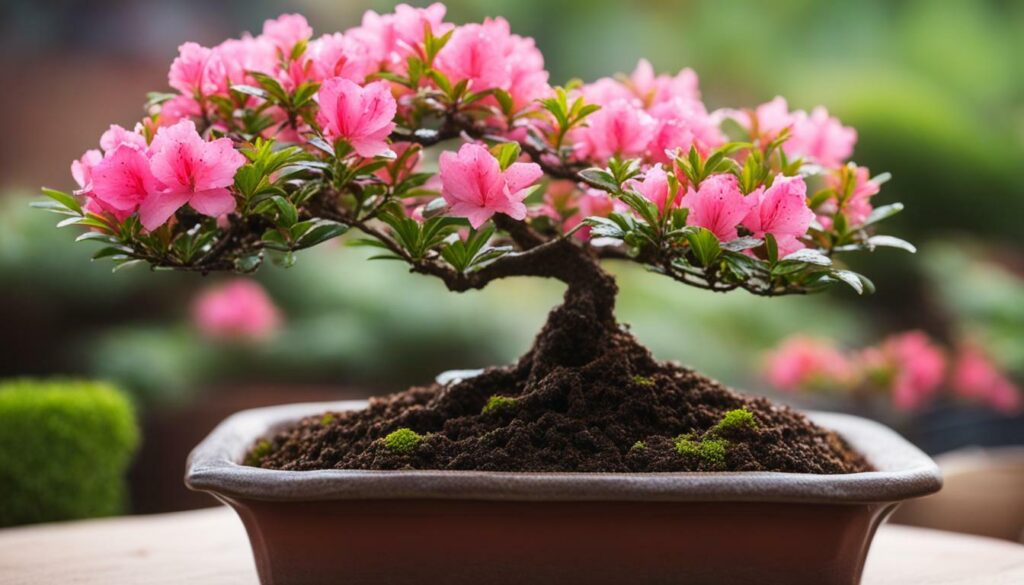
When watering your Azalea Bonsai, it is advisable to use rainwater or filtered tap water, as these trees are sensitive to chemicals and minerals found in some tap water sources. Rainwater can be collected and stored for future use, ensuring a clean and suitable water source for your bonsai. If rainwater is not readily available, filtered tap water is a suitable alternative.
Fertilizing and Feeding
Proper fertilizing and feeding are essential for the healthy growth of your ‘Azalea’ Bonsai. Fertilizers provide the necessary nutrients to support the tree’s overall development and ensure vibrant foliage and beautiful blooms. When it comes to ‘Azalea’ Bonsai care, using azalea or rhododendron-specific fertilizers is highly recommended.
Azaleas have specific nutritional requirements, and using fertilizers formulated specifically for these plants will provide the right balance of nutrients. These fertilizers are usually high in nitrogen, which encourages leafy growth, and contain lower amounts of phosphorus and potassium.
During the growing season, which typically starts in spring and lasts until fall, it is important to fertilize your ‘Azalea’ Bonsai regularly. Follow the instructions on the fertilizer packaging for the proper dosage and frequency. It is advisable to dilute the fertilizer to half strength to avoid overfertilizing, which can lead to root burn and other stress-related issues.
While fertilizing is crucial for the healthy development of your ‘Azalea’ Bonsai, it’s important to adjust the feeding schedule when the tree is flowering. During this period, reduce the frequency of fertilization to avoid potential damage to the delicate flowers. Once the flowering season is over, you can resume regular fertilization to support the tree’s growth and overall health.
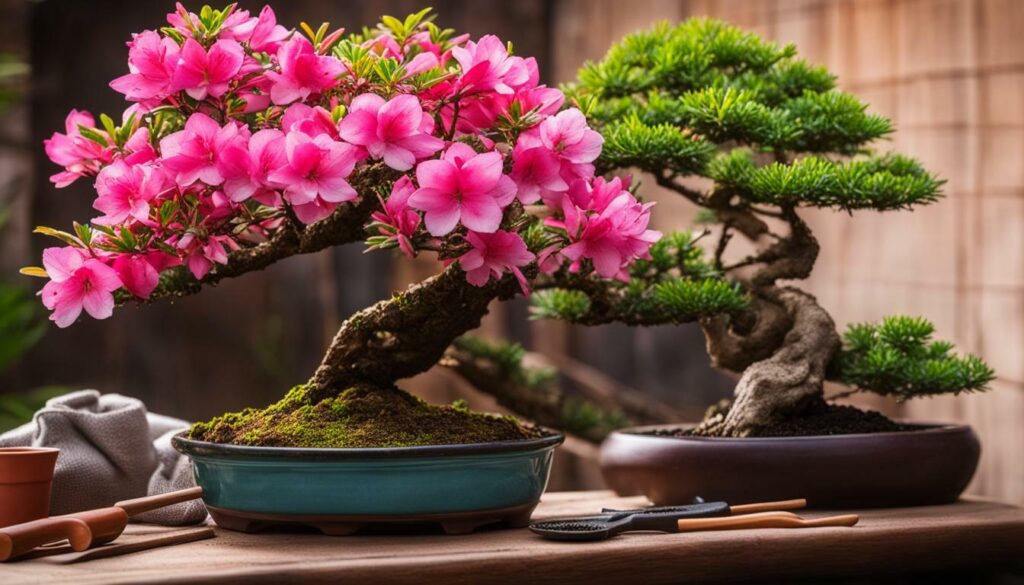
To help you understand the fertilizing and feeding needs of your ‘Azalea’ Bonsai, here is a table summarizing the key points:
| Aspect | Details |
|---|---|
| Fertilizer type | Azalea or rhododendron-specific fertilizers |
| Timing | During the growing season (spring to fall), reduce feeding during flowering |
| Dosage | Follow instructions on packaging; dilute to half strength |
Tip: Additional Nutritional Supplements
In addition to regular fertilization, you may consider using organic supplements to boost the health and vitality of your ‘Azalea’ Bonsai. Organic options, such as seaweed extract or fish emulsion, can provide beneficial trace elements and promote overall plant vigor. These supplements are often applied as foliar sprays or incorporated into the watering routine.
Proper fertilizing and feeding are integral parts of ‘Azalea’ Bonsai care. By understanding the specific nutrient needs of your tree and following the recommended fertilization practices, you can ensure its healthy growth and a stunning display of foliage and blooms.
- Use azalea or rhododendron-specific fertilizers.
- Fertilize regularly during the growing season.
- Reduce fertilization during the flowering period.
- Follow the instructions on the fertilizer packaging and dilute to half strength.
- Consider using organic supplements for additional plant nutrition.
Pruning and Wiring
Pruning and wiring are crucial aspects of maintaining the desired shape of your ‘Azalea’ Bonsai. With careful pruning, you can encourage new growth and shape the bonsai according to your aesthetic preferences. When pruning your azalea bonsai, it is important to focus on removing lower branches more aggressively than the top ones. This will help maintain the shrub-like appearance of the tree. Additionally, pruning should be done with clean and sharp tools to minimize damage to the branches.
Wiring is another technique that can be used to shape and train your azalea bonsai. By carefully wrapping wire around the branches, you can guide their growth and create the desired form. However, caution must be exercised as azalea branches are often brittle and can easily break. It is recommended to wire your bonsai in November when the branches are more flexible. Be sure to monitor the wiring regularly to prevent it from cutting into the branches as they continue to grow.
Pruning and Wiring Techniques:
- Use clean and sharp pruning shears to remove any dead, damaged, or overgrown branches.
- Focus on pruning the lower branches more aggressively to maintain the shrub-like shape.
- When wiring, start from the trunk and work your way up, carefully wrapping the wire around the branches.
- Monitor the wired branches regularly to prevent the wire from cutting into the bark.
- Remove the wire after a few months when the branches have set in the desired position.
Remember, pruning and wiring should be done with care and consideration for the overall health and aesthetic appeal of your azalea bonsai. It is recommended to learn proper techniques and seek guidance from experienced bonsai enthusiasts or professionals to ensure the best results.
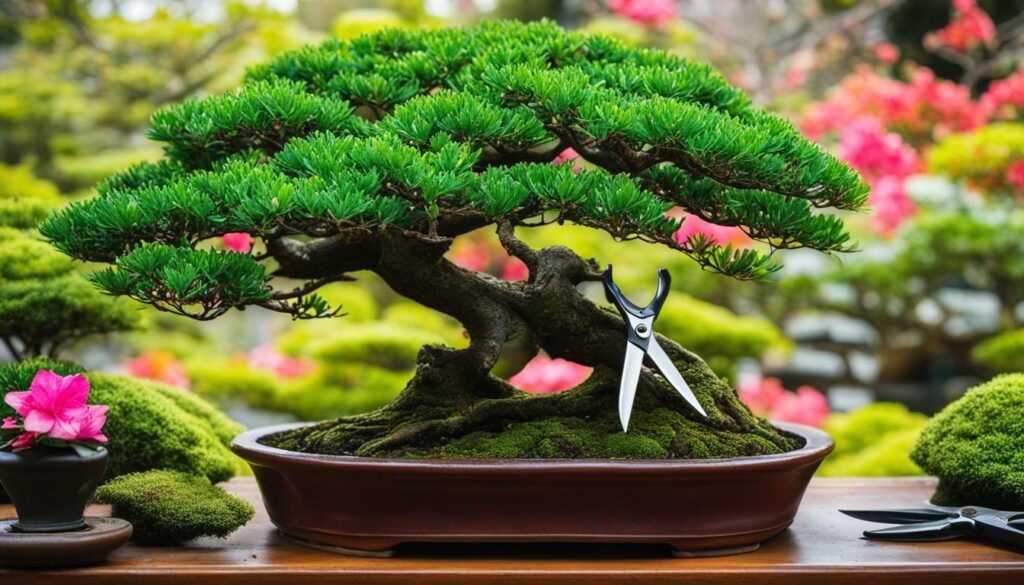
In conclusion, proper pruning and wiring techniques are essential for maintaining the desired shape and form of your ‘Azalea’ Bonsai. Be sure to prune and wire your bonsai with caution, focusing on removing lower branches more aggressively while using wire to guide the growth and achieve your desired design. By practicing these techniques and seeking guidance when needed, you can enhance the beauty of your azalea bonsai and ensure its long-term health.
Repotting and Root Pruning
Regular repotting and root pruning are essential for the continued health and vitality of your ‘Azalea’ Bonsai. Repotting should be done every two years, in early spring or after flowering, to ensure the tree has enough space to grow and develop. During the repotting process, it is important to examine the roots and prune them as necessary to maintain a healthy root system.
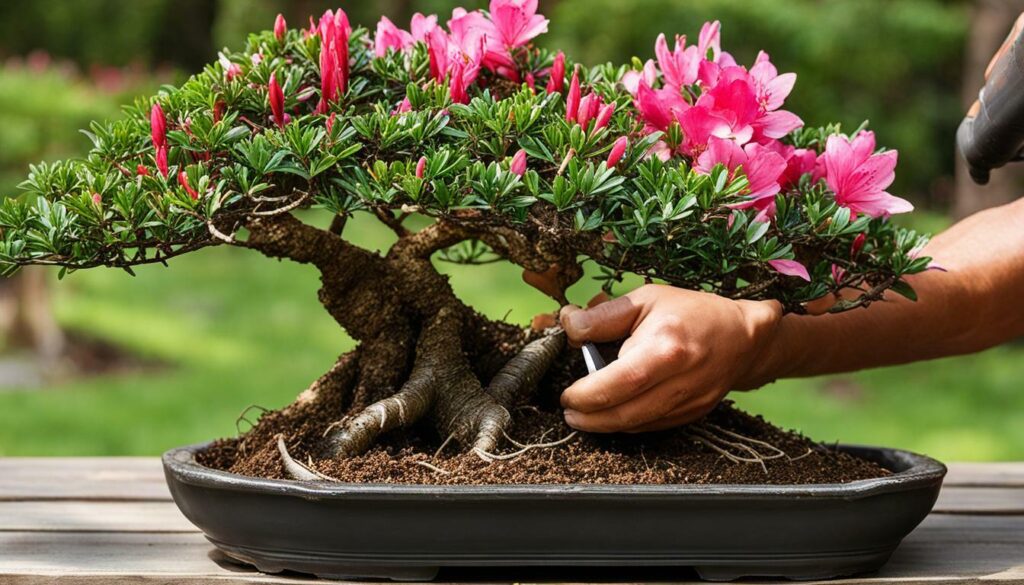
When repotting your ‘Azalea’ Bonsai, it is crucial to use special azalea soil that has good drainage properties. This will prevent the roots from being waterlogged and promote healthy growth. Azalea soil is typically a mix of peat moss, bark, and perlite, which provides the ideal balance of moisture retention and aeration.
| Repotting Schedule | Root Pruning |
|---|---|
| Every two years | Remove any circling or tangled roots |
| Early spring or after flowering | Trim long roots to stimulate new growth |
| Use special azalea soil for repotting | |
During the repotting process, it is important to handle the roots with care and avoid damaging them. Gently untangle any circling or tangled roots and trim any excessively long roots to stimulate new growth. After repotting, make sure to water the bonsai thoroughly to help it recover and settle into its new pot.
Benefits of Repotting and Root Pruning
Repotting and root pruning provide several benefits for your ‘Azalea’ Bonsai. Regular repotting prevents the root system from becoming compacted and allows for the replenishment of fresh nutrients in the soil. It also promotes the development of new feeder roots, which are essential for the absorption of water and nutrients.
Root pruning helps maintain a healthy root system by removing any damaged or diseased roots. This prevents the spread of diseases and ensures the efficient uptake of water and nutrients. Additionally, root pruning stimulates new root growth, which contributes to a stronger and more robust bonsai tree.
Propagation of ‘Azalea’ Bonsai
Propagating your own ‘Azalea’ Bonsai can be a rewarding experience in expanding your collection. By following a few simple steps, you can successfully grow new azalea bonsai trees from cuttings. This method allows you to preserve the unique characteristics of your favorite azalea variety and create more beautiful bonsai specimens.
To propagate azalea bonsai, start by selecting healthy, disease-free branches in the spring or summer. Choose semi-hardwood or hardwood cuttings that are about 4-6 inches long, ensuring that they have at least two sets of leaves. Before taking the cuttings, make sure to sterilize your tools to prevent the spread of diseases.
Once you have your cuttings, remove the lower set of leaves and dip the cut end into a rooting hormone powder to encourage root growth. Plant the cuttings in a mixture of perlite and peat moss, ensuring that they are planted deep enough to provide stability. Keep the soil moist and place the cuttings in a warm and humid environment, such as a greenhouse or a humidity dome.
After a few weeks, the cuttings should start to develop roots. You can check for root growth by gently tugging on the cutting. If there is resistance, it means roots have formed. At this point, you can carefully transplant the rooted cuttings into individual pots filled with well-draining bonsai soil. Provide them with proper care, including adequate sunlight, watering, and fertilizing, to ensure their healthy growth into thriving azalea bonsai trees.
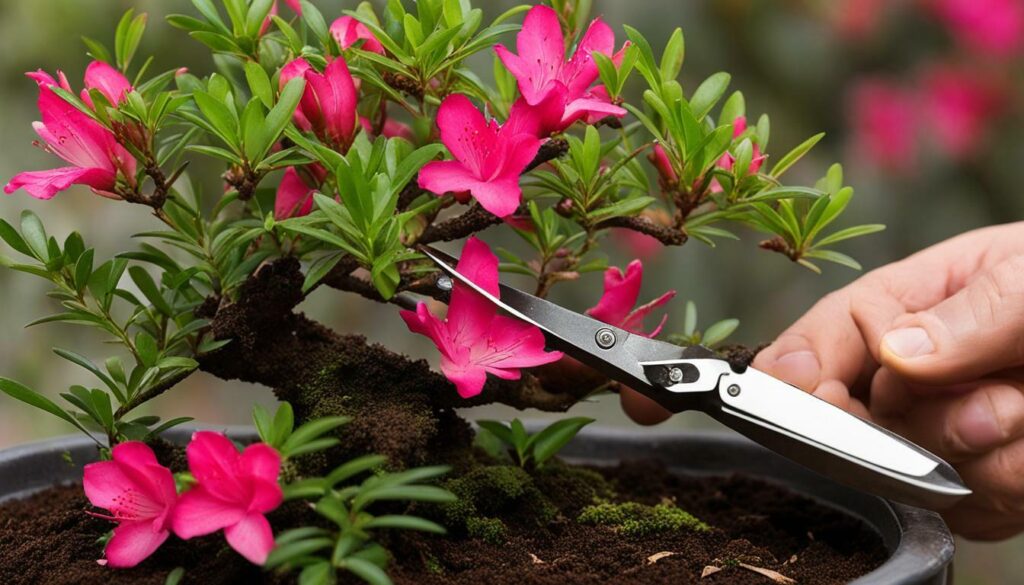
| Propagation Tips: | Common Mistakes to Avoid: |
|---|---|
|
|
Common Pests and Diseases
Protecting your ‘Azalea’ Bonsai from common pests and diseases is crucial for its long-term health. Azaleas are prone to various insects and fungal diseases, which can negatively impact their growth and overall appearance. Fortunately, with proper care and attention, you can prevent and treat these issues effectively.
Pests
Some common pests that can affect Azalea Bonsai include spider mites and vine weevils. Spider mites are tiny, sap-sucking insects that can cause yellowing leaves and webbing. To control spider mites, regularly inspect the undersides of leaves and use a strong stream of water to dislodge them. Neem oil or insecticidal soap can also be used as organic remedies. Vine weevils are nocturnal beetles that chew on the leaves and roots of Azalea Bonsai. Applying a biological control agent containing nematodes to the soil can help eliminate these pests.
Diseases
Azalea Bonsai are susceptible to various fungal diseases, such as root rot and leaf spot. Root rot is caused by overly wet soil and can be prevented by ensuring proper drainage. If you notice yellowing or wilting leaves and a foul smell coming from the soil, it may indicate root rot. To treat root rot, remove the affected parts and repot the bonsai in fresh, well-draining soil. Leaf spot, on the other hand, appears as dark spots on the leaves. To prevent leaf spot, avoid overhead watering and promptly remove any infected leaves.
| Pest or Disease | Symptoms | Treatment |
|---|---|---|
| Spider Mites | Yellowing leaves, webbing | Use strong water stream, neem oil, or insecticidal soap |
| Vine Weevils | Chewed leaves and roots | Apply biological control agent containing nematodes to the soil |
| Root Rot | Yellowing or wilting leaves, foul smell from soil | Remove affected parts, repot in fresh, well-draining soil |
| Leaf Spot | Dark spots on leaves | Avoid overhead watering, remove infected leaves |
By regularly inspecting your Azalea Bonsai for pests and diseases, you can catch any issues early and take appropriate action. Remember to provide suitable growing conditions, including proper lighting, watering, and fertilization, to ensure your bonsai tree remains healthy and thriving.
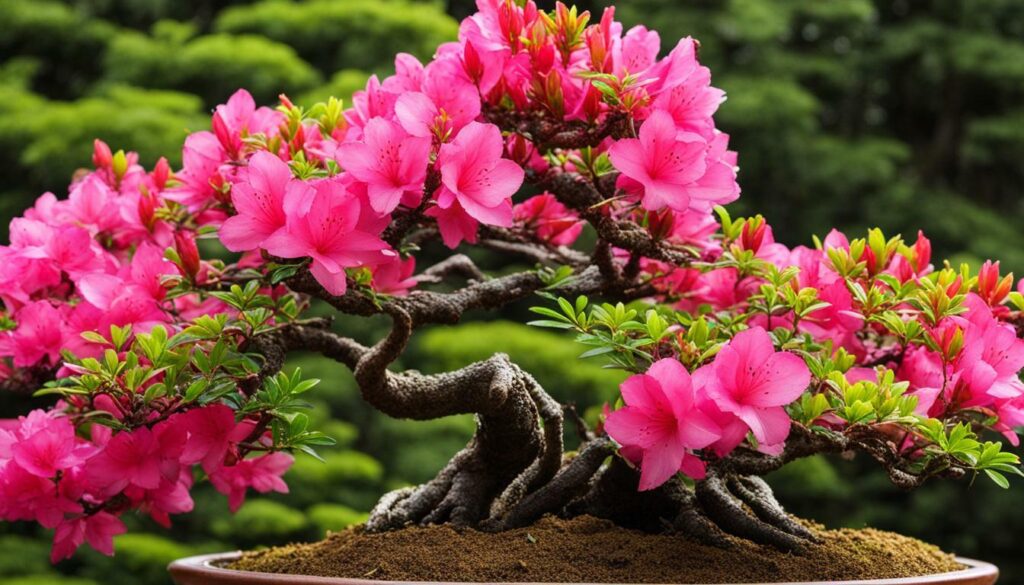
The Satsuki Azalea Bonsai is highly regarded for its stunning flowers and suitability for bonsai cultivation. This variety of azalea bonsai is known for its prolific blooms, which come in a wide range of colors and patterns, including shades of red, pink, purple, white, and variegated combinations. The Satsuki azalea’s ability to produce abundant flowers makes it a popular choice among bonsai enthusiasts.
When it comes to caring for the Satsuki Azalea Bonsai, there are several key factors to consider. This variety thrives in cool temperatures, making it ideal for outdoor cultivation in temperate climates. It requires filtered sunlight, as direct exposure to intense sunlight can scorch the leaves. Regular watering is essential to keep the soil moist, but it is important to avoid overwatering, as this can lead to root rot.
Fertilizing and pruning are crucial for the healthy growth and blooming of the Satsuki Azalea Bonsai. Fertilization should be done during the growing season, typically from early spring to mid-summer, using a balanced, organic bonsai fertilizer. Pruning should be done at specific times to encourage branching and compact growth. It is advisable to wire and shape the branches in November, being cautious with their brittleness.
Like all azalea bonsai trees, the Satsuki variety is susceptible to certain pests and diseases. Common insects that can affect the Satsuki Azalea Bonsai include spider mites and vine weevils. These pests should be treated promptly and appropriately to prevent damage to the bonsai. Fungal diseases, such as root rot or powdery mildew, can also occur, especially if the bonsai is overwatered or kept in humid conditions. Regular monitoring and proper care can help prevent and address these issues.
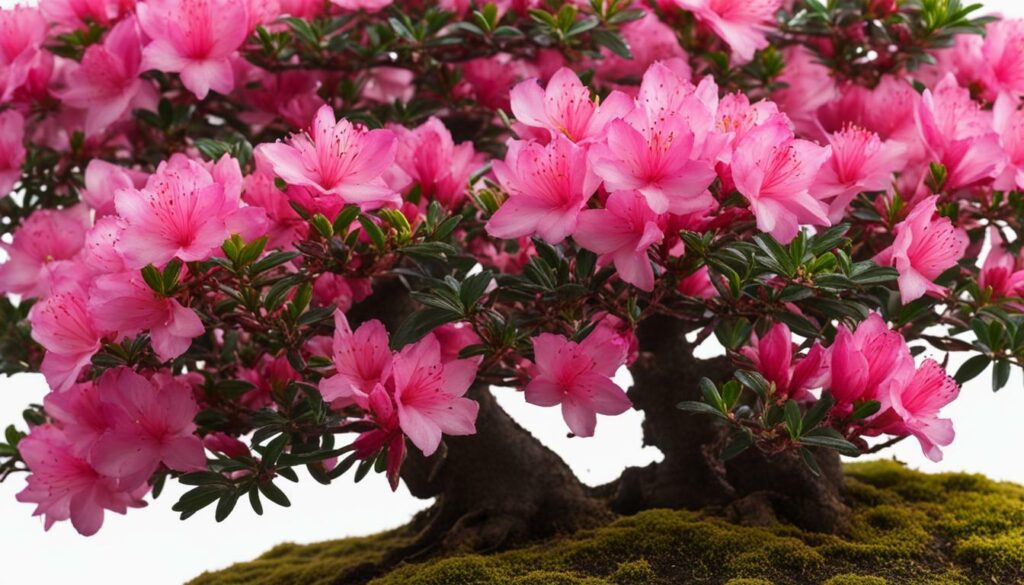
| Key Care Considerations for Satsuki Azalea Bonsai | |
|---|---|
| Temperature | Cool temperatures, ideally between 60-65°F (15-18°C) |
| Light | Filtered sunlight, avoiding direct exposure to intense sunlight |
| Watering | Regular watering to keep the soil moist but avoid overwatering |
| Fertilizing | Balanced, organic bonsai fertilizer during the growing season |
| Pruning | Prune at specific times to encourage branching and compact growth |
| Insects | Monitor for spider mites and vine weevils and treat promptly if necessary |
| Diseases | Prevent humid conditions and overwatering to avoid fungal diseases |
Conclusion
By following the comprehensive caring and maintenance guide, you can ensure the health and beauty of your ‘Azalea’ Bonsai for years to come. Proper care is crucial for the overall well-being of this popular bonsai tree.
Placement plays a significant role in the success of your ‘Azalea’ Bonsai. Remember to provide a sunny location while safeguarding it from extreme heat and rain. This will create the ideal growing conditions for your azalea.
Watering is an essential aspect of maintaining your ‘Azalea’ Bonsai. It is important to keep the soil moist without allowing it to become overly wet. Consider using rainwater or filtered tap water to provide the necessary hydration.
Fertilizing at the appropriate times with azalea or rhododendron-specific fertilizers is necessary for healthy growth. However, it is crucial to reduce feeding while the tree is flowering. This ensures the right balance of nutrients.
Pruning and wiring your ‘Azalea’ Bonsai should be done with care. Prune the lower branches more aggressively than the top to maintain the desired shrub-like shape. This will help your bonsai maintain its beauty for years to come.
Repotting every two years, using special azalea soil, is essential for the well-being of your ‘Azalea’ Bonsai. This provides the tree with fresh nutrients and ample space for root growth. Remember to pay special attention to root pruning during the repotting process.
Propagation of ‘Azalea’ Bonsai can be done through cuttings in the spring and summer. This allows you to expand your bonsai collection and share the beauty of azaleas with others.
It is important to be aware of common pests and diseases that can affect your ‘Azalea’ Bonsai. Spider mites, vine weevils, and fungal diseases are among the potential threats. Prompt detection and appropriate treatments are crucial for preserving the health of your bonsai.
The Satsuki Azalea is a popular choice among bonsai enthusiasts due to its prolific flowers and adaptability to container cultivation. Proper care for the Satsuki azalea, including cool temperatures, filtered sunlight, and regular watering, is essential to ensure its well-being.
Lastly, it is advisable to wire and shape your azalea bonsai in November, taking precautions with its brittle branches. This will help you maintain the desired form and aesthetic appeal of your bonsai.
With the right care and attention, your ‘Azalea’ Bonsai will thrive and bring beauty to your home or garden. Enjoy the process of caring for this beloved bonsai tree and witness its growth and magnificence over the years.
FAQ
Why is proper care and maintenance important for Azalea bonsai?
Proper care and maintenance are crucial for the health and longevity of Azalea bonsai. This ensures the tree’s overall well-being and helps it thrive in its bonsai form.
Where should I place my Azalea bonsai?
Azaleas thrive in sunny locations but should be protected from extreme heat and rain. Find a spot that provides ample sunlight while shielding the tree from harsh weather conditions.
How often should I water my Azalea bonsai?
Azalea bonsai requires regular watering to keep the soil moist. However, it is essential not to overwater and avoid leaving the soil overly wet. Aim to maintain a balanced level of moisture.
What type of water should I use to water my Azalea bonsai?
It is recommended to use rainwater or filtered tap water when watering your Azalea bonsai. This helps prevent mineral buildup in the soil, which can negatively affect the tree’s health.
When should I fertilize my Azalea bonsai?
It is necessary to fertilize your Azalea bonsai with azalea or rhododendron-specific fertilizers during the growing season. However, it’s important to reduce feeding while the tree is flowering.
How should I prune and wire my Azalea bonsai?
Pruning and wiring Azalea bonsai should be done with care. It is recommended to prune the lower branches more aggressively than the top to maintain the shrub-like shape. Handle wiring carefully, considering the tree’s brittle branches.
How often should I repot my Azalea bonsai?
Azalea bonsai should be repotted every two years, preferably in spring or after flowering. During repotting, remember to perform root pruning and use special azalea soil for optimal growth.
Can I propagate my Azalea bonsai?
Yes, you can propagate Azalea bonsai through cuttings in the spring and summer. Following the proper steps for successful propagation, you can create new bonsai trees from your existing Azalea.
What pests and diseases should I watch out for in Azalea bonsai?
Azalea bonsai is prone to pests such as spider mites and vine weevils, as well as fungal diseases. Vigilance and appropriate treatments are necessary to address these issues promptly.
How should I care for the Satsuki Azalea bonsai?
The Satsuki Azalea bonsai is known for its prolific flowers and adaptability to container cultivation. Care for this variety includes maintaining cool temperatures, filtered sunlight, regular watering, and proper fertilizing and pruning at specific times.
